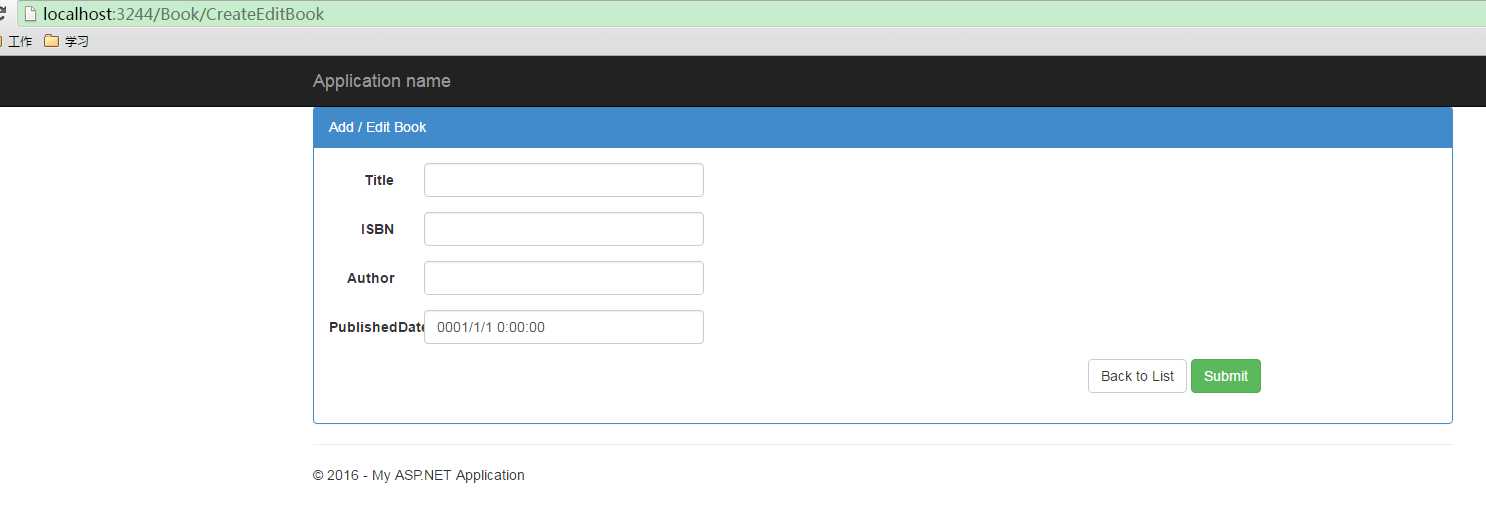标签:
系列目录:
这篇文章,我将会介绍在ASP.NET MVC应用程序中使用泛型仓储模式和工作单元。我将开发一个程序,对Book实体进行增删查改,为了保证这篇文章简单,便于大家理解泛型仓储模式和工作单元,在这篇文章中,我将只会使用一个Book实体。
在上篇文章中“4.CRUD Operations Using the Repository Pattern in MVC【在MVC中使用仓储模式进行增删查改】“讲到了仓储模式,里面我们为Book实体,创建了一个仓储类,但是这个仓储仅仅是只能为一个实体服务的。试想一下,如果是真正的企业级开发,我们会有很多实体,难道,我们要为每一个实体都创建一个仓储类么???显然是不现实的。对于这个问题,我们需要创建一个可以为所有实体公用的仓储,所以这里引入泛型仓储。这样就避免了重复编码。
下面的图中,讲到了两个开发者,讨论一个问题:"是否需要创建一个新的零件或者是利用已经存在的零件?" ------如果你选择第一种,那么就是这篇文章讲到的,"4.CRUD Operations Using the Repository Pattern in MVC【在MVC中使用仓储模式进行增删查改】"
但我在这里选择第二种,也就是这篇文章,我将要讲到的。--使用泛型仓储模式来重用代码,减少冗余代码。

既然说到仓储,那么什么是仓储模式呢?
仓储模式旨在数据访问层和业务逻辑层之间创建一个抽象层。仓储模式是数据访问模式,旨在达到数据访问的更松散的耦合性。我们在单独的类,或者类库中创建数据访问的逻辑,这就是仓储。仓储的职责就是和业务逻辑层进行通信。
在这篇文章中,我将会为所有的实体设计一个公共的泛型仓储,另外还有一个工作单元类。这个工作单元类,为每个实体创建仓储的实例,然后仓储实例用来做增删查改操作。我在控制器中创建工作单元类的实例,然后依据具体的实体,创建仓储的实例,然后就可以使用仓储中的方法进行每个操作了。
下面的图表显示了仓储和EF数据上下文之间的关系。在图中,MVC控制器直接通过工作单元和仓储进行交互,而不是直接和EF进行交互。

讲到这里,大家可能就会有疑问了,为什么要使用工作单元呢???
工作单元就像它的名字一样,做某件事情。在这篇文章中,工作单元主要做的是:我们创建工作单元的实例,然后工作单元为我们初始化EF数据上下文,然后每个仓储的实例都使用同一个数据上下文实例进行数据库操作。因此工作单元就是,用来确保所有的仓储实例都使用同一个数据上下文实例。
好了理论到此为止,讲的差不多了。现在我们开始进入正题:
先看看项目的结构:

这三个项目就不用做过多介绍了吧,前面的文章已经说了很多次了...
EF.Entity类库中,添加BaseEntity实体:
using System;
using System.Collections.Generic;
using System.Linq;
using System.Text;
using System.Threading.Tasks;
namespace EF.Entity
{
public abstract class BaseEntity
{
/// <summary>
/// ID编号
/// </summary>
public int ID { get; set; }
/// <summary>
/// 添加时间
/// </summary>
public DateTime AddedDate { get; set; }
/// <summary>
/// 修改时间
/// </summary>
public DateTime ModifiedDate { get; set; }
/// <summary>
/// IP地址
/// </summary>
public string IP { get; set; }
}
}
Book实体:
using System;
using System.Collections.Generic;
using System.Linq;
using System.Text;
using System.Threading.Tasks;
namespace EF.Entity
{
public class Book:BaseEntity
{
/// <summary>
/// 书名
/// </summary>
public string Title { get; set; }
/// <summary>
/// 作者
/// </summary>
public string Author { get; set; }
/// <summary>
/// ISBN编号
/// </summary>
public string ISBN { get; set; }
/// <summary>
/// 出版时间
/// </summary>
public DateTime PublishedDate { get; set; }
}
}
Entity.Data类库中BookMap类:
using EF.Entity;
using System;
using System.Collections.Generic;
using System.ComponentModel.DataAnnotations.Schema;
using System.Data.Entity.ModelConfiguration;
using System.Linq;
using System.Text;
using System.Threading.Tasks;
namespace EF.Data
{
public class BookMap:EntityTypeConfiguration<Book>
{
public BookMap()
{
//配置主键
this.HasKey(s => s.ID);
//配置字段
this.Property(s => s.ID).HasDatabaseGeneratedOption(DatabaseGeneratedOption.Identity);
this.Property(s => s.Author).HasColumnType("nvarchar").HasMaxLength(50).IsRequired();
this.Property(s => s.AddedDate).IsRequired();
this.Property(s => s.IP).IsOptional();
this.Property(s => s.ISBN).HasColumnType("nvarchar").HasMaxLength(50).IsRequired();
this.Property(s => s.ModifiedDate).IsOptional();
this.Property(s => s.PublishedDate).IsRequired();
this.Property(s => s.Title).HasColumnType("nvarchar").HasMaxLength(50).IsRequired();
//配置表名
this.ToTable("Books");
}
}
}
EF数据上下文类:
using System;
using System.Collections.Generic;
using System.Data.Entity;
using System.Data.Entity.ModelConfiguration;
using System.Linq;
using System.Reflection;
using System.Text;
using System.Threading.Tasks;
namespace EF.Data
{
public class EFDbContext:DbContext
{
public EFDbContext()
: base("name=DbConnectionString")
{ }
protected override void OnModelCreating(DbModelBuilder modelBuilder)
{
var typesToRegister = Assembly.GetExecutingAssembly().GetTypes()
.Where(type => !String.IsNullOrEmpty(type.Namespace))
.Where(type => type.BaseType != null && type.BaseType.IsGenericType
&& type.BaseType.GetGenericTypeDefinition() == typeof(EntityTypeConfiguration<>));
foreach (var type in typesToRegister)
{
dynamic configurationInstance = Activator.CreateInstance(type);
modelBuilder.Configurations.Add(configurationInstance);
}
//base.OnModelCreating(modelBuilder);
}
}
}
然后启用数据库迁移,自动生成数据库,这里的步骤就省略了,因为前面的文章已经说了。
接着,在EF.Data项目中创建泛型仓储类,里面提供了增删查改的方法,这个泛型的仓储类中,有一个带DbContext参数的构造函数,所以当我们实例化仓储的时候,传递一个数据上下文对象给仓储,所有的实体就可以使用同一个数据上下文对象了。我们使用了数据上下文的SaveChange方法,但是你同样可以使用工作单元类的Save方法,因为这两者使用的是同一个数据上下文对象,下面是泛型的仓储类代码:【为了使文章更容易理解,这里我不创建泛型的仓储接口】。
 View Code
View Code
下面创建工作单元类,UnitOfWork,这个工作单元类继承自IDisposable接口,所以它的实例将会在每个控制器中被 释放掉。工作单元类初始化了程序的上下文,工作单元类的核心就是Repository<T>() 类型的泛型方法,这个方法为继承自BaseEntity的每个实体返回了仓储实例。下面是工作单元类的代码:
using EF.Entity;
using System;
using System.Collections.Generic;
using System.Linq;
using System.Text;
using System.Threading.Tasks;
namespace EF.Data
{
public class UnitOfWork : IDisposable
{
private readonly EFDbContext db;
private bool disposed;
private Dictionary<string, object> repositories;
public UnitOfWork(EFDbContext context)
{
this.db = context; //构造函数中初始化上下文对象
}
public UnitOfWork()
{
db = new EFDbContext(); //构造函数中初始化上下文对象
}
#region Dispose
public void Dispose()
{
Dispose(true);
GC.SuppressFinalize(this);
}
public virtual void Dispose(bool disposing)
{
if (!disposed)
{
if (disposing)
{
db.Dispose();
}
}
disposed = true;
}
#endregion
#region Save
public void Save()
{
db.SaveChanges();
}
#endregion
#region Repository<T>()
public Repository<T> Repository<T>() where T : BaseEntity
{
if (repositories == null)
{
repositories = new Dictionary<string, object>();
}
var type = typeof(T).Name;//获取当前成员名称
if (!repositories.ContainsKey(type))//如果repositories中不包含Name
{
var repositoryType = typeof(Repository<>);//获取Repository<>类型
var repositoryInstance = Activator.CreateInstance(repositoryType.MakeGenericType(typeof(T)), db);
repositories.Add(type, repositoryInstance);
}
return (Repository<T>)repositories[type];
}
#endregion
}
}
好了,底层的代码,写完了,现在开始写控制器的代码:我们创建一个Book控制器,进行增删查改。
 View Code
View Code
Index 视图代码:
@model IEnumerable<EF.Entity.Book>
<div class="book-example panel panel-primary">
<div class="panel-heading panel-head">Books Listing</div>
<div class="panel-body">
<a id="createEditBookModal" href="@Url.Action("CreateEditBook")" class="btn btn-success">
<span class="glyphicon glyphicon-plus"></span>Book
</a>
<table class="table" style="margin: 4px">
<tr>
<th>
@Html.DisplayNameFor(model => model.Title)
</th>
<th>
@Html.DisplayNameFor(model => model.Author)
</th>
<th>
@Html.DisplayNameFor(model => model.ISBN)
</th>
<th>
Action
</th>
<th></th>
</tr>
@foreach (var item in Model)
{
<tr>
<td>
@Html.DisplayFor(modelItem => item.Title)
</td>
<td>
@Html.DisplayFor(modelItem => item.Author)
</td>
<td>
@Html.DisplayFor(modelItem => item.ISBN)
</td>
<td>
@Html.ActionLink("Edit", "CreateEditBook", new { id = item.ID }, new { @class = "btn btn-success" }) |
@Html.ActionLink("Details", "DetailBook", new { id = item.ID }, new { @class = "btn btn-primary" }) |
@Html.ActionLink("Delete", "DeleteBook", new { id = item.ID }, new { @class = "btn btn-danger" })
</td>
</tr>
}
</table>
</div>
</div>
CraeteEdit视图代码:
@model EF.Entity.Book
@{
ViewBag.Title = "Create Edit Book";
}
<div class="book-example panel panel-primary">
<div class="panel-heading panel-head">Add / Edit Book</div>
<div class="panel-body">
@using (Html.BeginForm())
{
<div class="form-horizontal">
<div class="form-group">
@Html.LabelFor(model => model.Title, new { @class = "col-lg-1 control-label" })
<div class="col-lg-9">
@Html.TextBoxFor(model => model.Title, new { @class = "form-control" })
</div>
</div>
<div class="form-group">
@Html.LabelFor(model => model.ISBN, new { @class = "col-lg-1 control-label" })
<div class="col-lg-9">
@Html.TextBoxFor(model => model.ISBN, new { @class = "form-control" })
</div>
</div>
<div class="form-group">
@Html.LabelFor(model => model.Author, new { @class = "col-lg-1 control-label" })
<div class="col-lg-9">
@Html.TextBoxFor(model => model.Author, new { @class = "form-control" })
</div>
</div>
<div class="form-group">
@Html.LabelFor(model => model.Published, new { @class = "col-lg-1 control-label" })
<div class="col-lg-9">
@Html.TextBoxFor(model => model.Published, new { @class = "form-control datepicker" })
</div>
</div>
<div class="form-group">
<div class="col-lg-8"></div>
<div class="col-lg-3">
@Html.ActionLink("Back to List", "Index", null, new { @class = "btn btn-default" })
<button class="btn btn-success" id="btnSubmit" type="submit">
Submit
</button>
</div>
</div>
</div>
}
</div>
</div>
@section scripts 这里的话,在布局页中要添加这个块: @RenderSection("scripts", required: false)
{
<script src="~/Scripts/bootstrap-datepicker.js" type="text/javascript"></script>
<script src="~/Scripts/book-create-edit.js" type="text/javascript"></script>
}
DeleteBook视图:
 View Code
View CodeDetail视图:
 View Code
View Code修改一下默认路由为Book控制器,Index方法,然后运行项目》》》





标签:
原文地址:http://www.cnblogs.com/jinguanzhang/p/5809929.html